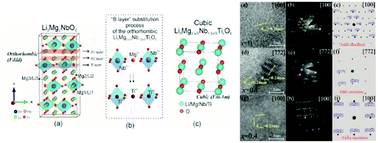Structural evolution and microwave dielectric properties of a novel Li3Mg2−x/3Nb1−2x/3TixO6 system with a rock salt structure†
Abstract
In this study, the Li3Mg2−x/3Nb1−2x/3TixO6 (0 ≤ x ≤ 0.6) solid solution was designed and synthesized by the solid-state reaction method. The ordering degree decreased with the increasing Ti content, and the ordered orthorhombic superstructure was continuously transformed to the disordered MgO-like cubic subcell structure with no other impure phase observed in the range of 0.12 ≤ x ≤ 0.38. During the phase transition process, the ordered domains were found in orthorhombic superstructures by TEM images. According to the variation of Raman patterns, the B1g, B2g and B3g vibration modes which derive from Nb–Nb repulsive force in 8a sites were assigned to the band at 480 cm−1. The relative densities and dielectric constants showed a similar nonlinear variation with the increase of Ti content. However, as x increased from 0 to 0.4, the phase transition contributed to the huge improvement of Q × f values from 82 338 GHz to 125 357 GHz (about 50%), but it also led to a slight decrease in the temperature coefficient of resonant frequency (τf). After being sintered at 1260 °C for 6 h, the Li3Mg1.87Nb0.73Ti0.40O6 (x = 0.4) ceramics showed excellent microwave properties: εr = 15.09, Q × f = 125 357 GHz and τf = −31.7 ppm °C−1.

- This article is part of the themed collection: Inorganic Chemistry Frontiers HOT articles for 2018


 Please wait while we load your content...
Please wait while we load your content...